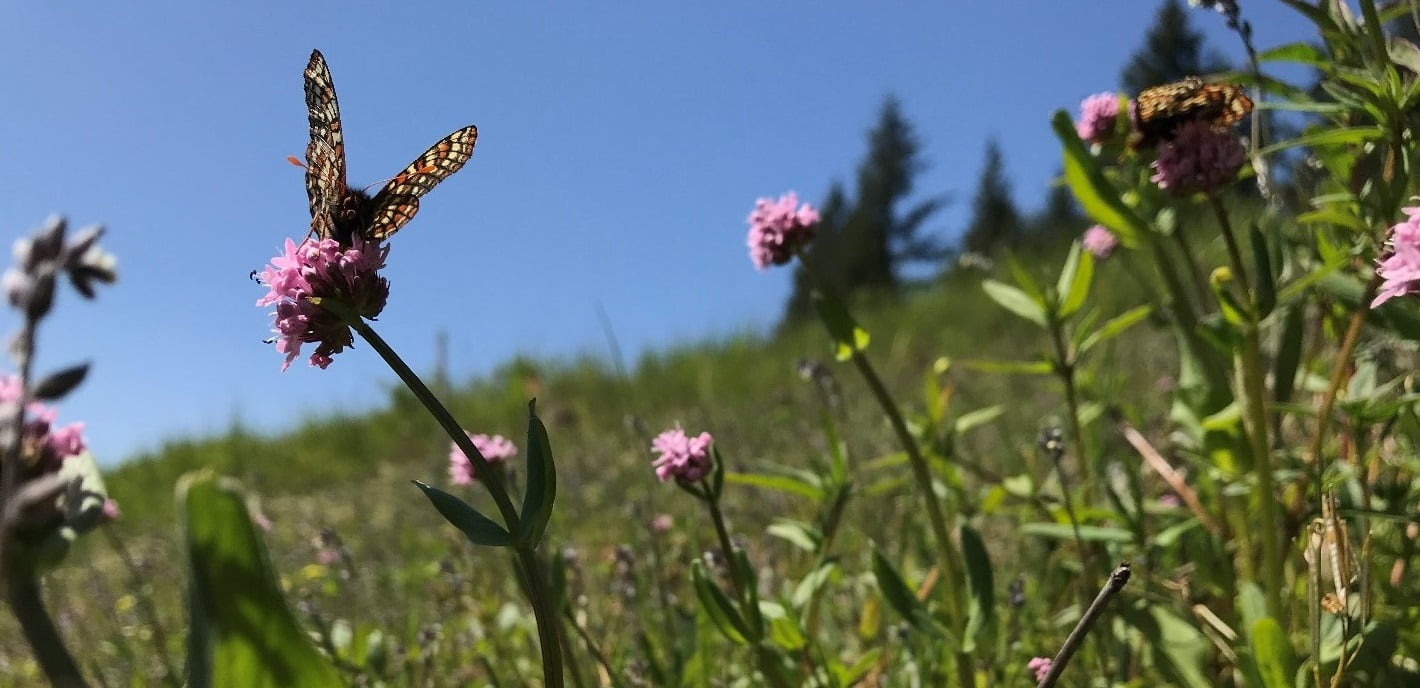
Taylor’s checkerspot – the fair weather butterfly
May 2019
Location: Benton County (Site names and locations excluded to protect sensitive species and habitats)
Many of you are probably familiar with the Fender’s blue butterfly (Icaricia icarioides fenderi), sometimes used as the poster child of prairie restoration in Oregon and rightfully so. It is likely that some of you have noticed the Fender’s blue mosaic by local artist Caroline Moses on Monroe Avenue here in Corvallis. Better yet, some of you might have even been lucky enough to see this endangered species in the wild. However, did you know that there is another endangered butterfly in our area? The Taylor’s checkerspot butterfly (Euphydryas editha taylori) is one of the rarest butterflies in the Pacific Northwest and is found at only two locations in Oregon, both in Benton County! The loss, degradation, and fragmentation of the historically abundant Willamette Valley prairie habitat have nearly driven this butterfly to extinction in our state. Taylor’s checkerspot butterfly’s low numbers and its tendency to remain in its rearing habitat have likely prevented it from being seen in Oregon by more than a handful of lucky people. For over a decade, IAE has been involved in restoring Taylor’s habitat for the two remaining Oregon populations, and it has been a challenging pursuit.
These finicky butterflies thrive when nectar sources, such as rosy plectritis (Plectritis congesta), western buttercup (Ranunculus occidentalis), and wild strawberry (Fragaria virginiana), are abundant and they tend to stay close to home, even when these resources are limited. The low mobility of the Taylor’s checkerspot makes it dependent on local site conditions, which can be easily affected by weather and nectar source availability during the flight season. These factors can cause the number of butterflies to fluctuate significantly from year to year. For example, the long wet winter followed by a late spring in 2017 likely contributed to a drop in the number of butterflies from 2,730 in 2016 to 773 individuals in 2017 at one location and from 675 to 252 at the other. When butterflies emerge later than normal due to cool, wet weather, they can miss the flowering period of important nectar species. Cold, wet, or windy conditions can also prevent a butterfly from finding a mate. Who knows what impact a changing climate could have on the future this species?

Taylor’s checkerspot restoring on a thatch of nonnative grass.

Pair of Taylor’s checkerspot nectaring on spring gold (Lomatium utriculatum).

Taylor’s checkerspot nectaring on a golden paintbrush (Castilleja levisecta)
With the help of other IAE staff and volunteers and funding and assistance from the Oregon Watershed Enhancement Board, US Fish and Wildlife Service, and Benton County Natural Areas and Parks, native seed and plugs were restored to areas cleared of weeds, trees and shrubs in fall 2017 and 2018. Now that spring has sprung in 2019, many of these species are blooming, and the butterflies are bouncing from flower to flower even as I write this blog!
The Taylor’s checkerspot flight season began in April, and the weather since then was consistently warm and dry, which is perfect for Taylor’s checkerspot to find nectar and mates. Early in the flight season, I watched dozens of these butterflies take flight when the sun came out as they searched for western buttercup and strawberry flowers. They would rise into the air when the sun’s warmth hit them, and land again when the next cloud blocked the sun. On another day, the warm weather kept the butterflies hopping from flower to flower, occasionally swirling straight up into the air in their mating dance with another butterfly before coming back down to nectar on the flowers again. When the wind picked up, the butterflies were forced to roost on flowers, shrubs, and last year’s stems only to release and haphazardly make their way to the next flower.
It appears that all of our work is paying off. With good weather and increased host and nectar species availability, Taylor’s checkerspot numbers are increasing again and hopefully this trend will continue!
Restoration
Research
Education
Contact
Main Office:
4950 SW Hout Street
Corvallis, OR 97333-9598
541-753-3099
info@appliedeco.org
Southwest Office:
1202 Parkway Dr. Suite B
Santa Fe, NM 87507
(505) 490-4910
swprogram@appliedeco.org
© 2025 Institute for Applied Ecology | Privacy Policy
